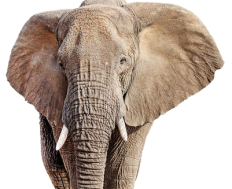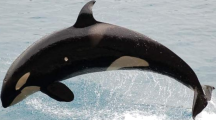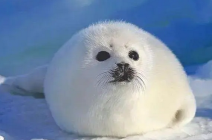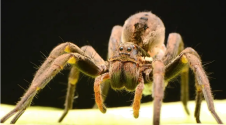More than a score of Australian rare mammals have been killed by wild cats. These predators, which arrived with European settlers, still threaten native wildlife — and are too plentiful on the mainland to eliminate, as has been achieved on some small islands which were previously filled with them. But Alexandra Ross of the University of New South Wales thinks she has come up with a different way to deal with the problem. As she writes in a paper in the Journal of Applied Ecology, she is giving feline (猫科的) — awareness lessons to wild animals involved in re-introduction programs, in order to try to make them cat-conscious.
Many Australian mammals, though not actually extinct, are restricted to fragments of cat-free habitat. This will, however, put the forced migrants back in the sights of the cats that caused the problem in the first place. Training the migrants while they are in captivity, using stuffed models and the sorts of sounds made by cats, has proved expensive and ineffective. Ms Ross therefore wondered whether putting them in large natural enclosures with a scattering of predators might serve as a form of training camp to prepare them for introduction into their new, cat-ridden homes.
She tested this idea on a type of bandicoot (袋狸) that superficially resembles a rabbit. She and her colleagues raised two hundred bandicoots in a huge enclosure that also contained five wild cats. As a control, she raised a nearly identical population in a similar enclosure without the cats. She left the animals to get on with life for two years, which, given that bandicoots breed four times a year and live for around eight years, was a considerable period for them. After some predation (扑食) and probably some learning, she abstracted 21 bandicoots from each enclosure, attached radio transmitters to them and released them into a third enclosure that had ten hungry cats in it. She then monitored what happened next. The outcome was that the training worked. Over the subsequent 40 days, ten of the untrained animals were eaten by cats, but only four of the trained ones. One particular behavioral difference she noticed was that bandicoots brought up in a predator-free environment were much more likely to sleep alone than were those brought up around cats. And when cats are around, sleeping alone is dangerous. How well bandicoots that have undergone this extreme training will survive in the wild remains to be seen. But Ms Ross has at least provided reason for hope.
1. What can be learned from the first paragraph?| A.The feline-awareness lessons have proved ineffective. |
| B.There are too many wild cats to be killed in Australia. |
| C.Different ways have been tried to hunt and kill wildlife. |
| D.Native wildlife has been threatened by a growing population of wild cats. |
| A.Australian mammals restricted to certain areas |
| B.The wild cats tracking down the mammals |
| C.Wild animals involved in the program |
| D.The predators captured by the animal trainers |
| A.They were both closely monitored. | B.They had 200 bandicoots in total. |
| C.They had similar natural environment. | D.They both had wild cats in them. |
| A.Untrained bandicoots failed to identify cats. |
| B.Training bandicoots prepared them to fight cats. |
| C.Sleeping alone in the wild was dangerous. |
| D.Bandicoots could be trained to avoid predators. |
相似题推荐
【推荐1】We arrived at the cat shelter on the same day. I needed something to keep me busy outside school and decided to volunteer at the city’s cat shelter. One-year-old female cat Linni arrived that day with its mother. They were painfully shy. They’d lived for years locked in a house with no light or socialization, just an occasional bag of cat food thrown down to them after their loud complaint.
All our cats were sociable, eager to greet visitors for adoption. Linni’s mother found a new home, but Linni was terrified of everything, always hiding somewhere when I arrived for work, inside the darkness or under the furniture.
If someone tried to pet her, she’d be terrified. I’d routinely search for her at the start, leaving her food and sitting on the floor to talk to her softly. After several months, she’d sometimes appear slowly, looking at me while eating the food I’d brought. Instead of petting her, I’d talk to her as she ate and watched me. I knew that, being badly treated before, she saw her trust as a weakness or an invitation for bad people to hurt her.
I discovered she adored soft cloth. I’d offer her blankets and towels, carefully selected, at her feet. She’d bury her head in them. A mistreated child was learning there were soft and comforting things out there.
Winter came. It had been a year since Linni and I came. One day, when her head was buried in the folds of a soft woolen blanket, I tried to pet her, and she didn’t run away. I took her home to my small apartment. Gradually, we learned to trust and love each other.
A decade later, when I come home from work, she’ll be there to greet me. As a veterinary(兽医) nurse now, I specialize in cat behaviour and health. But I learned all my techniques and patience from Linni. She gave me a career.
1. How was Linni’s life before moving to the shelter?| A.She was left alone by her mother. | B.She had several failed adoptions. |
| C.She suffered at her owner’s hands. | D.She didn’t get on well with other cats. |
| A.She liked to complain loudly about being petted. | B.She regarded it as a cause of further hurt to her. |
| C.She thought it strange to make human friends. | D.She missed her former owners and adoptions. |
| A.Lying buried under some soft cloth. | B.Taking cover under some furniture. |
| C.Being invited to the author’s home. | D.Playing with the other cats outside. |
| A.Saving mistreated cats. | B.Treating cat diseases. |
| C.Studying animal habitat. | D.Learning cat behaviour. |
African elephants These beautiful beasts come close to imitating teen rebellion. Kids spend a decade with their mothers in female -dominated groups~~and ladies stay there-but adolescent boys leave mom for noisy crews of brothers. In their 20s, they often downsize to smaller male groups. |
Orangutans Slow metabolisms (新陈代谢)allow them to survive food shortages—times when weather makes ripe fruit scarce. But energy efficiency comes at a cost; growth and maturation take time. Orangutan mamas nurse their young longer than any other wild creature does. |
Orcas Killer whales join their mother’s familial group for life. This forever-bond seems to increase a baby’s chance of survival; if mom dies, a young male (under 30) is three times more likely to die than a peer whose mother is alive. Risk of death post-mom-death rises as kids get older. |
Humans Why do we take so long to bake? Our big brains need up to 25 years to mature—a period that might make us more innovative. One study of teens and young adults found that youths outperformed their older generations in tasks requiring exploration and adaptation. |
Harp seals A harp seal’s “childhood” lasts just 12 days. A baby’s only purpose during that brief period of growing is to constantly nurse, gaining a fifth of its birth weight in blubber (鲸脂)every day. Once it’s heavy enough its weight increasing about 25 to 80 pounds it slides off the ice and. |
WoW spiders Every parent knows that tired kids love to take a piggyback ride. The wolf spider straps all her youngins (40 or 50, on average) onto her back at once, carrying them until they are capable of fully functional spider-hood. But luckily she only has to carry them for a few days. takes on the sea. |
| A.African elephants. | B.Orangutans. |
| C.Orcas. | D.Humans. |
| A.Both are good at surviving food shortages. |
| B.Both need a relatively long time to mature. |
| C.Both get more intelligent than old generations. |
| D.Both are able to slow down their metabolisms. |
| A.Their childhood lasts even shorter than wolf spiders. |
| B.Their weight generally ranges from 25 to 80 pounds. |
| C.They can gain about six pounds each day before they go to the sea. |
| D.They usually nurse each other during the first 12 days of their life. |
To perfect a particular smell, perfume-makers often use an ingredient that comes from sperm whales, called ambergris (龙涎香). But using ambergris, which helps a perfume last longer, is strongly opposed by many people who think it is wrong to kill whales just so we can smell sweet. Joerg Bohlmann is neither a perfumer nor a whale expert. He's a plant biologist at the University of British Columbia in Canada. But his discovery of a new plant gene (基因) might push whales out of the perfume business.
The gene comes from fir trees, found throughout North America and commonly used as Christmas trees. The trees produce a chemical that can be used in perfume in place of ambergris-but with a catch "There's a problem that many people wouldn't consider. In the tree, the chemical is mixed with many others. That makes separation a challenge," Bohlmann says. "lt's like trying to isolate sugar from a biscuit. "
This is where science becomes useful. When Bohlmann learned that fir trees produce the ambergris-like chemical, he decided to use his gene know-how to find the instructions for how to make the ambergris-substitute.
Bohlmann found that gene and took it out of the tree cells. Then he did something that might sound strange to someone who doesn't work in genetics: Bohlmann put the gene from the tree into yeast (酵母) cells.
Yeast may sound familiar because it's used to make things like bread, wine and beer. Biologists like to work with yeast because it easily adopts new genes and changes its features and behaviour. When Bohlmann put the fir tree gene into the yeast, the yeast started making the same chemical that had been produced by the tree.
Perfumers pay big money for ambergris because it is a fixative, which means it holds a smell in place on a person's body.
"Cheap perfumes smell good in the first hour or so and then everything is gone," explains Bohlmann. "But expensive perfumes are much more stable. Their smell lasts much longer, for hours or even a day after you apply them. "
The new chemical, made from the tree genes, can be used as a fixative, too. And using yeast to make it is far cheaper than acquiring ambergris.
Bohlmann admits he never thought he'd get into the perfume business. But now, he says, producers have been calling to find out how to use his technology in new perfumes.
1. It can be inferred from the passage that if a perfume contains ambergris, .
| A.its user probably supports whale hunting |
| B.it is probably very expensive |
| C.its smell will last for about an hour |
| D.there will be a whale symbol on the bottle |
| A.being difficult to hold |
| B.being too similar |
| C.having a hidden problem |
| D.needing further testing |
| A.They're much cheaper to use than ambergris. |
| B.They can reproduce much faster than other cells. |
| C.They share some of the qualities of plant genes. |
| D.They can take on the characteristics of other genes. |
| A.He is opposed to whale hunting. |
| B.He made his discovery during Christmas. |
| C.He has worked in the perfume industry for many years. |
| D.He has previously done genetic research. |
【推荐1】Please don't feel singled out, special, or view yourself as a chosen one. She bites everyone. This is just the nature of the beast. There is absolutely no truth to the persistent myths that mosquitoes fancy females over males; that they prefer blondes and redheads over those with darker hair;or that the darker or rougher your skin, the safer you are from her bite. It is true, however, that she does play favorites and feasts on some more than others.
Blood type O seems to be the choice over types A and B or AB. People with blood type O get bitten twice as often as those with type A, with type B falling somewhere in between.
Those who have higher natural levels of certain chemicals in their skin, particularly lactic acid (乳酸),also seem to be more attractive. From these elements, she can analyze which blood type you are. These are the same chemicals that determine an individual’s level of skin bacteria and unique body smell.
Mosquitoes are also attracted by perfumes, soaps, and other applied fragrances. While this may seem unfair to many of you, she also has a desire for beer drinkers.
Wearing bright colors is also not a wise choice, since she hunts by both sight and smell, the latter depending chiefly on the amount of carbon dioxide sent out by the potential target. So she can smell carbon dioxide from over 200 feet away. When you exercise, for example, you emit more carbon dioxide through both breath and output. You also sweat, releasing those appetizing chemicals, primarily lactic acid, that invites the mosquito's attention.
Lastly, your body temperature rises, which is an easily identifiable heat signature. On average, pregnant women suffer twice as many bites, as they have a slightly raised body temperature.
Please don't go on a shower, exercise or give up your beloved beer and bright T-shirts just yet. Unfortunately, 85% of what makes you attractive to mosquitoes is fixed in advance in your genetic circuit board (电路板).At the end of the day, she will find blood from any exposed target of opportunity.
1. What is the purpose of the first paragraph?| A.To explain the reasons for mosquito bites. |
| B.To introduce a new discovery to the readers. |
| C.To prove that everyone suffers mosquito bites. |
| D.To arouse the interest of the readers in the topic. |
| A.Blood type. | B.Chemicals of bacteria. |
| C.Color of clothes. | D.Body temperature. |
| A.All the mosquito bites are caused by your genetic circuit board. |
| B.Your blood will be targeted by mosquitoes at every opportunity. |
| C.Mosquito bites can be avoided if you give up some relevant habits. |
| D.Your genes determine your attractiveness to mosquitoes to a great extent. |
| A.Keep off Mosquitoes | B.Mosquito Bites Let Nobody off |
| C.Why are You a Mosquito Feeder | D.Mosquitoes, a Threat to Our Health |
【推荐2】To us humans, climate change feels like something that’s happening to the atmosphere, but actually about 90% of the heat that gets trapped by greenhouse gases is absorbed by the ocean. Of course, the ocean is really big, and taking its temperature is hard. Now, however, scientists have developed a technique that allows them to measure temperature changes across entire ocean basins.
The idea dates back to the 1970s, when researchers first proposed using sound waves to study ocean warming, because the speed of sound through water depends on the physical properties of that water, which are related to temperature. “And roughly, if we warm up the ocean temperature by one degree Celsius, the sound speed change-it would be four meters per second. And this is a very sensitive change.” said Wenbo Wu, a seismologist at Caltech, who led the study.
Researchers originally proposed using artificial sound sources, but that proposal got prevented because of concerns about the impacts on marine(海洋的) animals. In the new study, however, Wu and his colleagues show they can use the sounds produced by earthquakes instead. In an earthquake, some vibrations(振动) bounce off the seafloor and turn into sound waves that get picked up by a special machine and underwater microphones. The researchers looked at the travel times of these sound waves for 2,000 pairs of earthquakes that occurred in the East Indian Ocean between 2005 and 2016. Each earthquake pair happened in the same place but at different times, allowing the researchers to measure how much the sound waves sped up.
The analysis revealed that the waves traveled a few tenths of a second faster in more recent quakes than in older ones—a difference that translates to a warming trend of 0.04 degrees Celsius per decade. “0.04 degree may not sound like a lot, but it represents a huge amount of heat—considering it’s the change in a body of water almost 2,000 miles wide and several miles deep.” said Wu.
1. What does “a technique” in paragraph 1 refer to?| A.Trapping greenhouse gases. | B.Using artificial sound waves. |
| C.Measuring the width and depth of the ocean. | D.Employing the sounds of quake vibrations. |
| A.The sea is vast enough. | B.The statistics are accurate. |
| C.The equipment is advanced. | D.Each earthquake pair is conditional. |
| A.The sound waves slowed down with time. |
| B.The ocean temperature went up in the decade. |
| C.The speed change of sound waves was considerable. |
| D.2,000 pairs of earthquakes occurred in the same place. |
| A.Ocean Warming: A Booster of Climate Change |
| B.Seaquake Soundwave: A Tracker of Ocean Warming |
| C.Sound Waves: An Initiative in Studying Ocean Animals |
| D.Ocean Basins: Where Earthquakes Frequently Happen |
【推荐3】Could blood shortages become a thing of the past? Bacterial enzymes (W) from the human gut (肠,内脏)turn type A blood into the type universally accepted for transfusions, and do it more efficiently than current methods.
Our blood comes in four main varieties: A, B, AB and O. The red blood cells in each type are similar in shape, but they have different sugars on their surfaces. Red blood cells in type A host a particular set of these sugars, with type B having a different set. AB blood cells carry both A and B sugars and type O cells have none.
These sugars can act as antigens(抗原),causing an immune response. For instance, transfusing type B blood into someone with type A can cause death. That is what makes anyone with type O blood a universal donor: there are none of these antigens. So being able to remove these sugars from A, B and AB type blood would be helpful, effectively making it usable in transfusions for all.
"We knew that those same sugars that are on our red blood cells are also produced on the inside of the gut wall," says Steve Withers at the University of British Columbia, Canada. So he and his colleagues started searching for bacteria in human waste (粪便)that might make enzymes that let them feed on and break down gut wall sugars.
Analyzing bacterial genes, they found a family of enzymes that help gut bacteria harvest the sugars. When the team combined the enzymes with type A blood, the sugars were removed from the blood cells, resulting in type O blood. The process is 30 times more efficient than an existing one involving other enzymes.
The bacterial enzymes will have to go through more safety testing before they can be used in blood for human transfusions, but it is a promising step, says Withers. He presented the work at a meeting of the American Chemical Society in Boston this week.
1. Why is a man with type O blood a universal donor?| A.The similar shape of his red blood cells. |
| B.No sugars on his red blood cells. |
| C.Different sugars on the blood cells. |
| D.Different quantity of his red blood cells. |
| A.By analyzing bacteria genes. |
| B.By combining the enzymes with blood. |
| C.By removing the enzymes from the cells. |
| D.By involving different enzymes in blood. |
| A.Fashion and Lifestyle. |
| B.Finance and Business. |
| C.Travel and Sports. |
| D.Medicine and Health. |
【推荐1】The human eye can physically perceive(感知) millions of colours. But we don't all recognise these colours in the same way.
Colour perception is less about seeing what is actually out there and more about how our brain interprets colours to create something meaningful. The perception of colour mainly occurs inside our heads and is closely related to personal experience.
Different languages and cultural groups carve up the colour spectrum differently. Some languages like Dani, spoken in Papua New Guinea, and Bassa, spoken in Liberia, only have two terms, dark and light. Dark roughly translates as cool in those languages, and light as warm. So colours like black, blue, and green are cool colours, while lighter colours like white, red, orange and yellow are warm colours.
Remarkably , most of the world's languages have five basic colour terms. Cultures as diverse as the Himba in the Namibian plains and the Berinmo in the rainforests of Papua New Guinea employ such five term systems. As well as dark, light, and red, these languages have a term for yellow, and a term that represents both blue and green. That is, these languages do not have separate terms for “green” and “blue” but use one term to describe both colours, a sort of “grue”.
Historically, Welsh had a “grue” term, namely “glas”, as did Japanese and Chinese. Nowadays, in all these languages, the original “grue” term has been restricted to blue, and a separate green term is used. This is either developed from within the language—as is the case for Japanese—or through lexical borrowing, as is the case for Welsh.
The way we perceive colours can also change during our lifetime. Greek speakers, who have two fundamental colour terms to describe light and dark blue (“ghalazio” and “ble”),tend to see these two colours as more similar after living for long periods of time in the UK. There, these two colours are described in English by the same fundamental colour term: blue.
This is because after long term everyday exposure to an English-speaking environment, the brain of native Greek speakers starts interpreting the colours “ghalazio” and “ble” as part of the same colour category.
1. Which of the following can be best used to describe colour perception?| A.Subjective. | B.Realistic. |
| C.Reliable. | D.Helpful. |
| A.Glas. | B.Green. |
| C.Blue. | D.Green and blue. |
| A.English speakers can hardly perceive the color blue. |
| B.The two colours make little difference to English speakers. |
| C.There is no need to distinguish between the two colours. |
| D.The two colours are not so important to English speakers. |
| A.Colour Terms Vary from Country to Country |
| B.Languages Change What Colours We See |
| C.Languages Influence the Ability to Perceive Colours |
| D.Colours Change with Language Development |
【推荐2】A heavy feeling on the chest. A throat that’s leaden. An overwhelming feeling of isolation. Loneliness hurts—and, over time, it can put the body into a state that increases our risk of everything from heart attack and stroke to diabetes and cancer. So, evolutionarily speaking, why do we experience it?
Stephanie Cacioppo, a neuroscientist at the University of Chicago Pritzker School of Medicine, says that countless studies have helped researchers formulate a holistic(全面的)purpose for loneliness. “Our social structures evolved hand in hand with neural, hormonal and genetic mechanisms to support these social structures—like couples, tribes and communities—that help us survive and reproduce,” says Cacioppo. Because while loneliness may be painful to experience today, for our prehistoric ancestors that pain would have been a far better alternative to being caught alone with a predator on the prowl(潜行).
Being social had its downsides even back then—competition for food, for example, or contribution to the spread of pathogens(病原体). But scientists think we evolved to feel loneliness because it was more important to work with one another to accomplish tasks and to protect everyone. “The pain of loneliness prompted us to renew the social structure so we could survive and promote key features like trust, cooperation and collective action, explains Cacioppo.
For years, researchers thought of loneliness as a disease. But now, they’re realizing that it’s more of a biological hunger signal that reminds us when it’s time to reconnect with those around us to promote our short-term survival. If the outcomes of loneliness were entirely negative, it would no longer be a part of our DNA. “Hunger and thirst protect our physical body while loneliness protects our social body,” says Cacioppo.
Loneliness impacts us all differently. Some of us may find certain situations lonely even while others don’t. There’s also a genetic component: Some of us are born to feel lonelier than others. Other factors play a role, too. The way we were treated as children can also inform how lonely we feel as adults. Lonely people spend most of their time deep within their own imaginations; they may conceptualize social encounters so much, in fact, that this part of their brain is in overdrive. That means even though they may be desperate to form connections, when they’re around other people, they’re actually less likely to be present.
1. As for loneliness, which would the author agree with?| A.It can lead to serious mental problems in adulthood. |
| B.It holds potential risks and disadvantages to individuals. |
| C.It may reflect a person’s strong desire to have social bonds. |
| D.It is perceived in the same way as it is demonstrated by our DNA. |
| A.beneficial but risky | B.painful but necessary |
| C.natural and powerful | D.personal and harmful |
| A.Humans evolved to be lonely. | B.Loneliness is a curable disease. |
| C.Loneliness is a personal feeling. | D.Humans need to address loneliness. |
【推荐3】Surfing the net when you should be finishing a work report, changing clothes when you have a train to catch, or perhaps even lying in bed when you’ve promised yourself you’ll work out. Sound familiar? You aren’t alone. We all procrastinate ( 拖 延 ) sometimes, especially when it comes to things we aren’t really fond of. And while the number of activities we delay doing in any given week varies from person to person, it’s fair to say that none of us is super-efficient 100 percent of the time.
A study revealed that we spend about 218 minutes procrastinating every day, which amounts to 55 days of lost time each year. We might not think these figures particularly worthy of worry, but when we look at the overall impact of procrastination on our lives, it’s a different story. Not only does this cost financial loss, it also affects peace of mind. And procrastination isn’t just a money thief - it steals time too. In general, people who continually put things off are unhappier, as well as being less wealthy and healthy.
So why do we do it? “When we avoid taking action, we’re really avoiding pain,” explains psychiatrist (精神病学家) Phil Stutz. For most of us, pain avoidance isn’t limited to one situation. It applies to almost anything that’s painful. Most of us try our best never to leave a comfort zone. That’s why we sacrifice something much more valuable: time. “Our time on earth is limited,” Stutz adds. “Every moment is an opportunity we’ll never have again. Procrastinators act as if they have all the time in the world. But deep down, they know they’re wasting parts of their life. The trouble is, most of them don’t know how to free themselves.”
One way he says we can reach this level of freedom is by overcoming the pain of avoidance using daily visualization (想象). “Picture the pain you’re avoiding as a black cloud in front of you,” Stutz says. “Notice how you’re fed up with the ways this pain has held you back in life, and tell yourself that you’re determined to conquer it. Then it’s time to get through the cloud and to the other side — where you’re free.” It is obvious that this tool works when we want to procrastinate. We then get into the habit of moving “towards” pain instead of away from it.
In addition to the fact that procrastinators suffer more health problems, procrastination also destroys teamwork and personal relationships because it shifts the burden of responsibilities onto others. So next time you think about putting something off, remember the impact it will have. Experts insist: procrastinators can change their behavior, it takes a lot of self-work but in the end, it’s worth the effort. And start today, not tomorrow.
1. By saying “it’s a different story”, the writer thinks procrastination________.| A.leads to different results for different persons |
| B.is likely to have bad effects on people’s life |
| C.may not be particularly worthy of concern |
| D.tends to cause unhappiness among people |
| A.get accustomed to taking action | B.prefer to stay in the comfort zone |
| C.don’t know how to free themselves | D.are not aware of the limited time |
| A.overcome it mentally | B.avoid the pain |
| C.take some self-work | D.reach the freedom |
| A.To analyze the trouble procrastination causes. |
| B.To show what contributes to procrastination. |
| C.To solve the problems caused by procrastination. |
| D.To encourage people to defeat procrastination |









